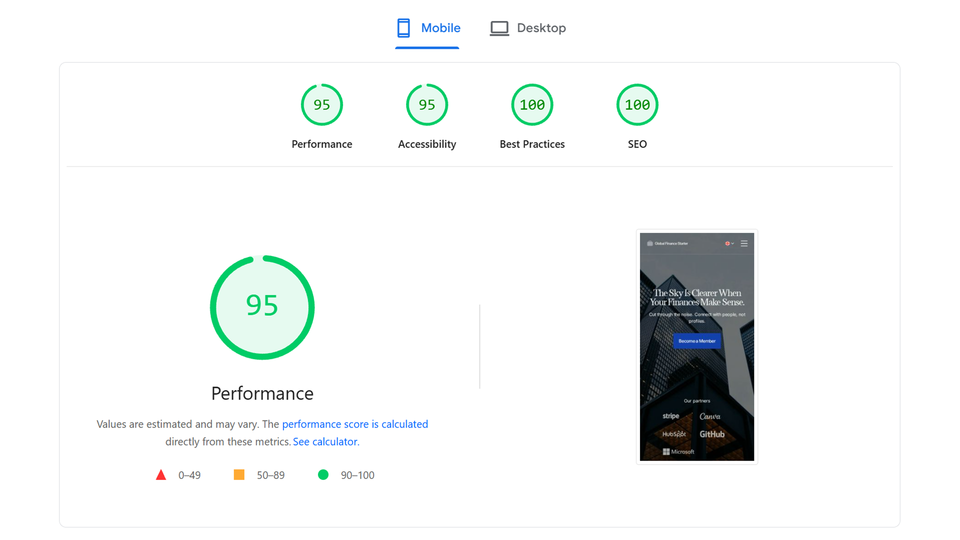October 13, 2025
5 min
How Astro and Netlify Power Our Financial Template
 MS
MSMojtaba SeyediContent Writer
See how Astro and Netlify bring speed, security, and reliability to our financial template — helping teams deliver high-performance, globally available websites with zero DevOps overhead.
In our previous post, we showed how Storyblok gives financial teams the freedom to create and manage content with ease. But a great content experience is only half the battle. The other half is delivering that content to users with unmatched speed, security, and reliability.
That’s where the final two pieces of our stack come in: Astro, the static-site engine that builds incredibly fast websites, and Netlify, the platform that launches them to a global audience instantly.
Think of it this way: if Storyblok is the intuitive cockpit where your team pilots the content, then Astro is the high-performance engine under the hood, and Netlify is the automated launchpad that gets it into orbit. Together, they ensure that every piece of content crafted in Storyblok reaches the end-user with maximum speed and reliability.
Let's dive into why we chose Astro and Netlify, and how they help financial services teams deliver high-performance, secure, and future-proof websites.
Astro: Performance by Default
Financial websites are typically content-heavy — think reports, product pages, and regulatory updates. They don’t usually need complex, app-like interactivity but instead demand fast-loading, content-driven pages that rank well in search and build trust with users. This is exactly what Astro was built for. Let’s break it down.
As an official Astro Partner, we’ve had the opportunity to put the framework through its paces on real-world projects. That’s why we feel confident recommending it to financial services teams looking for both performance and scalability.
Content driven
Unlike other frameworks, Astro is focused on content. Their tagline says it all: "The web framework for content-driven websites." It's the perfect fit for marketing sites, landing pages, and corporate sites where fast, static content is the priority.
Fast loads
Most modern frameworks ship a lot of JavaScript to the browser. That means users wait longer for pages to become interactive, especially on mobile devices. For financial services companies, this creates a real problem. A campaign page that takes five seconds to load doesn't just frustrate users—it costs conversions.
Astro takes a different approach. It renders pages to HTML at build time and only sends JavaScript when absolutely necessary. This means pages load instantly because there's simply less to download and process.
In our template, this translates to the performance scores shown below:

Better SEO
Financial services rely heavily on organic search— and performance plays a very important role in this aspect. Google prioritizes fast, mobile-friendly sites. Higher PageSpeed scores not only lead to better search rankings but also builds trust and improves engagement for users.
Interactivity when needed
Campaign pages sometimes call for interactive components. Astro’s "islands architecture" doesn't lock you in. You can use React, Vue, Svelte, or other frameworks for those specific interactive components, so the rest of the page remains fast, static HTML.
This "bring-your-own-framework" approach means your team can use the tools they already know and are comfortable with.
Scalable and global-ready
Whether you're managing one site or dozens of regional brands, Astro's lightweight foundation holds up. Its routing system makes it simple to scale for multilingual and global content without adding complexity.
Seamless Storyblok Integration
The official @storyblok/astro package makes the connection smooth and efficient, which shortens development time and reduces costs.
Crucially, Astro’s support for SSR is what powers the stable live preview in Storyblok we demonstrated earlier. Editors see their changes in real-time, exactly as they will appear live.
Netlify: Reliable Deployment and Hosting
Building a fast site is only part of the journey. You also need a reliable way to get it live and keep it running smoothly. This is where Netlify comes in. The process is simple (actually Netlify makes it seem simple for us): When a developer pushes a change to the GitHub repository, Netlify automatically builds the Astro site and deploys it to its global content delivery network (CDN) aka Continuous Integration/Continuous Deployment (CI/CD).
Instant Deploys from Git
The moment you push code to your connected GitHub repository, Netlify automatically builds the Astro site and deploys it globally. This continuous deployment means your live site is always in sync with your codebase, eliminating manual uploads and reducing human error.
Fast Global Delivery
Financial services companies serve customers across different regions. Netlify hosts sites on a global network of edge servers, so a user in London, New York, or Tokyo gets content from a server geographically close to them.
This results in consistently fast load times anywhere in the world which is critical for global financial brands.
Zero DevOps overhead
No need to manage servers or pipelines. Netlify handles the infrastructure, so teams can stay focused on campaigns instead of configs.
Preview deployments
Compliance is a constant concern in financial services. Before any page goes live, multiple people often need to review it: marketing checks the messaging, legal reviews the disclosures, and compliance ensures everything meets regulations. Netlify makes this easier with preview deployments. Every change gets its own temporary URL that looks and works exactly like the live site. Teams can review, comment, and approve without touching production. Once approved, the change goes live with a single click.
Instant Rollbacks
Mistakes happen. When they do, Netlify's one-click rollback feature lets teams instantly revert to a previous working version. This safety net provides peace of mind—especially when launching time-sensitive campaigns.
Zero-Downtime
Netlify ensures a new version of the site is fully ready before the old one is taken down. There's no interruption in service—critical for any financial institution where uptime equals trust.
Serverless Functions for Dynamic Features
Even static sites need dynamic elements — contact forms, lead capture, or financial data integrations. Netlify Functions let you add these without spinning up a separate backend.
We’ve used Netlify to power dozens of client projects, from large-scale enterprise websites to high-traffic marketing campaigns. You can explore some of our work on our official Netlify agency page.
How It All Fits Together
The magic is in how these tools connect. Here’s the simplified workflow from content update to live site:
- Edit in Storyblok: A marketing manager updates a hero banner or publishes a new blog post in the Storyblok visual editor.
- Trigger a Build: Storyblok sends a webhook to Netlify, notifying it that the content has changed.
- Astro Rebuilds: Netlify pulls the latest content from Storyblok's API and runs the astro build command. Astro generates a new set of static pages, incorporating the fresh content.
- Netlify Deploys: The newly built site is instantly deployed to Netlify's CDN and becomes live across the globe.
This entire process happens automatically in minutes, giving content teams the agility they need while ensuring the final website remains blisteringly fast and secure.
What’s Next
With Storyblok for content, Astro for performance, and Netlify for deployment, the template is ready to use out of the box. You can explore it on GitHub, try the demo, and see how the stack works together.
But a modern website isn't complete without the ability to learn and optimize. In the next post, we'll introduce the final piece of the puzzle: PostHog. We'll show you how this integrated analytics platform allows you to run A/B tests, track user behavior, and make data-driven decisions to improve conversion rates and user engagement.
Ready to See It for Yourself?
- Grab the template directly from the Astro Themes page.
- Get the code on GitHub and deploy instantly on Netlify.
And if you’re looking for a version tailored to your specific business needs, get in touch—we can help you adapt it.
Get in touch




